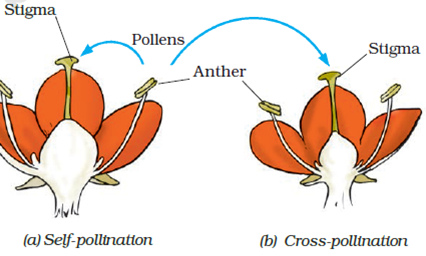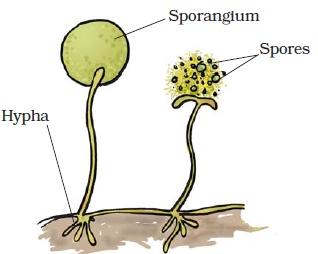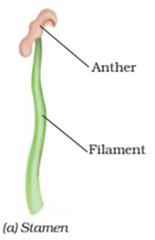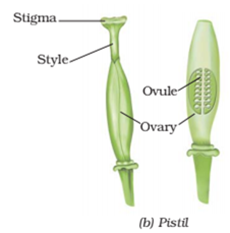Extra Questions for Class 7 Science Chapter 12 Reproduction In Plants
Extra questions for Class 7 Science Chapter 12 Reproduction In Plants with answers is given below. Our subject expert prepared these solutions as per the latest NCERT textbook. These questions will be helpful to revise the all topics and concepts. CBSE Class 7 extra questions are the most simple and conceptual questions that are prepared by subject experts for the students to study well for the final exams. By solving these extra questions, students can be very efficient in their exam preparations.
Reproduction In Plants Class 7 Science Extra Questions and Answers
Very Short Extra Questions and Answer
1. Which is the reproductive part of a plant?
Answer: Flower is the reproductive part of a plant.
2. Name the cell formed as product of fertilization.
Answer: The cell which results after fusion of the gametes is called a zygote.
3. What is the male reproductive part of a flower?
Answer: Stamens are the male reproductive parts of flowers.
4. What is the female reproductive part of a flower?
Answer: Pistil is the female reproductive part of a flower.
5. What mature ovary turns into?
Answer: Mature ovary turns into a fruit.
6. What is a node?
Answer: A node is a part of the stem/branch at which a leaf arises.
7. Give examples of plants that reproduce by means of spores.
Answer: Plants such as moss and ferns reproduce by means of spores.
8. How fungi grow on bread?
Answer: Fungi on a bread piece grow from spores which are present in the air.
9. What are the two modes of reproduction in plants?
Answer: In plants there are two modes of reproduction, asexual and sexual.
10. What is fertilisation?
Answer: The process of fusion of male and female gametes (to form a zygote) is called fertilization.
Short Extra Questions and Answers
1. What is reproduction?
Answer: The production of new individuals from their parents is known as reproduction.
2. Which plant grows from roots?
Answer: The roots of some plants can also give rise to new plants. Sweet potato and dahlia are examples.
3. How do cacti reproduce?
Answer: Plants such as cacti produce new plants when their parts get detached from the main plant body. Each detached part can grow into a new plant.
4. What is pollination? Name its types.
Answer: The transfer of pollen from the anther to the stigma of a flower is called pollination. Pollination is of two types, self-pollination and cross-pollination.
5. What are unisexual flowers? Give examples.
Answer: Flowers which contain either only pistil or only stamens are called unisexual flowers. Corn, papaya and cucumber produce unisexual flowers.
6. What are bisexual flowers? Give examples.
Answer: Flowers which contain both stamens and pistil are called bisexual flowers. Mustard, rose and petunia have bisexual flowers.
7. What are the different modes of asexual reproduction?
Answer: There are several methods of asexual reproduction such as fragmentation, budding, spore formation and vegetative propagation.
8. What are the vegetative parts of plants?
Answer: In vegetative propagation new plants are produced from different vegetative parts such as leaves, stems and roots.
9. Explain what you understand by sexual reproduction.
Answer: Sexual reproduction produces offspring by the fusion of gametes, resulting in offspring genetically different from the parent or parents.
10. State the main difference between asexual and sexual reproduction.
Answer: In asexual reproduction plants can give rise to new plants without seeds, whereas in sexual reproduction, new plants are obtained from seeds.
11. What will happen if all seeds of a plant were to fall at the same place and grow there?
Answer: There would be severe competition for sunlight, water, minerals and space. As a result the seeds would not grow into healthy plants.
12. What is the function of flowers in plants?
Answer: The flowers perform the function of reproduction in plants. Flowers are the reproductive parts of a plant. A flower may have either the male part or the female part or both male and female parts.
13. How are plants benefited by seed dispersal?
Answer: Plants benefit by seed dispersal. It prevents competition between the plant and its own seedlings for sunlight, water and minerals. It also enables the plants to invade new habitats for wider distribution.
14. What types of seeds are dispersed by animals?
Answer: Some seeds are dispersed by animals, especially spiny seeds with hooks which get attached to the bodies of animals and are carried to distant places. Examples are Xanthium and Urena.
15. How do potatoes reproduce?
Answer: Potatoes can be grown asexually by vegetative reproduction. This can be done by planting a part of potato with an eye and watering it regularly for few days. The new stem start on the eyes of the potato and a potato plant will develop.
Long Extra Questions and Answers
1. How do plants reproduce?
Answer: There are several ways by which plants produce their offspring. These are categorised into two types: (i) asexual and (ii) sexual reproduction. In asexual reproduction plants can give rise to new plants without seeds, whereas in sexual reproduction, new plants are obtained from seeds.
2. How does sexual reproduction take place in flowering plants?
Answer: Anther contains pollen grains which produce male gametes. A pistil consists of stigma, style and ovary. Ovary contains one or more ovules. The female gamete or the egg is formed in an ovule. In sexual reproduction a male and a female gamete fuse to form a zygote.
3. Explain the difference between self-pollination and cross-pollination.
Answer: If the pollen lands on the stigma of the same flower it is called self-pollination. When the pollen of a flower lands on the stigma of another flower of the same plant, or that of a different plant of the same kind, it is called cross-pollination.
4. How can we grow a new rose plant from the parent plant?
Answer: A new rose plant can be grown by cutting off a part of the stem of an existing plant, with two or more nodes, and planting it in the ground. A node is a part of the stem from where a leaf grows. This stem grows into a new rose plant.
5. How fruits and seeds are formed?
Answer: After fertilisation, the ovary grows into a fruit and other parts of the flower fall off. The fruit is the ripened ovary. The seeds develop from the ovules. The seed contains an embryo enclosed in a protective seed coat. Some fruits are fleshy and juicy such as mango and orange. Some fruits are hard like almonds and walnuts.
6. How do algae reproduce?
Answer: Slimy green patches are seen in ponds, or in other stagnant water bodies. These are the algae. When water and nutrients are available algae grow and multiply rapidly by fragmentation. An alga breaks up into two or more fragments. These fragments or pieces grow into new individuals. This process continues and they cover a large area in a short period of time.
7. What do you mean by vegetative propagation? Explain with example.
Answer: It is a type of asexual reproduction in which new plants are produced from roots, stems, leaves and buds. Since reproduction is through the vegetative parts of the plant, it is known as vegetative propagation. Most yeasts reproduce asexually by an asymmetric division process called budding. When water and nutrients are available algae grow and multiply rapidly by fragmentation.
8. How plants such as moss and ferns reproduce?
Answer: Plants such as moss and ferns also reproduce by means of spores. Spores are asexual reproductive bodies. Each spore is covered by a hard protective coat to withstand unfavourable conditions such as high temperature and low humidity. So they can survive for a long time. Under favourable conditions, a spore germinates and develops into a new individual.
9. How does reproduction take place in yeast?
Answer: Yeast is a single-celled organism. The small bulb-like projection coming out from the yeast cell is called a bud. The bud gradually grows and gets detached from the parent cell and forms a new yeast cell. The new yeast cell grows, matures and produces more yeast cells. Sometimes, another bud arises from the bud forming a chain of buds. If this process continues, a large number of yeast cells are produced in a short time.
20. How does the process of fertilisation take place in flowers?
Answer: When ripe pollen from an anther of the same kind of flower catches on the stigma, each pollen grain sends out a tiny threadlike tube. The tube grows down through the style and pierces one of the ovules in the ovary. This pollen tube carries a male gamete to meet a female gamete in an ovule. Two gametes fuse together to form zygote. The process of fusion of male and female gametes (to form a zygote) is called fertilisation. The zygote develops into an embryo.
21. Show self-pollination and cross pollination via a labelled diagram.
Answer:

22. How the male gamete in the pollen grain reaches the female gamete present in the ovule?
Answer: Generally pollen grains have a tough protective coat which prevents them from drying up. Since pollen grains are light, they can be carried by wind or water. Insects visit flowers and carry away pollen on their bodies. Some of the pollen lands on the stigma of a flower of the same kind. Some pollen of a flower may lands on the stigma of a flower of a different plant of the same kind. Pollen grain on the stigma grows a tiny tube, all the way down the style to the ovary. This pollen tube carries a male gamete to meet a female gamete in an ovule.
23. Sketch the reproductive parts of a flower.
Answer:
24. Describe the various ways by which seeds are dispersed.
Answer: Seeds and fruits of plants are carried away by wind, water and animals.
- Winged seeds such as those of drumstick and maple, light seeds of grasses or hairy seeds of aak (Madar) and hairy fruit of sunflower get blown off with the wind to far away places.
- Some seeds are dispersed by water. These fruits or seeds usually develop floating ability in the form of spongy or fibrous outer coat as in coconut. Some seeds are dispersed by animals, especially spiny seeds with hooks which get attached to the bodies of animals and are carried to distant places. Examples are Xanthium and Urena.
- Some seeds are dispersed when the fruits burst with sudden jerks. The seeds are scattered far from the parent plant. This happens in the case of castor and balsam.
25. Explain reproduction through spore formation in fungus.
Answer: Fungi on a bread piece grow from spores which are present in the air. When spores are released they keep floating in the air. As they are very light they can cover long distances. Spores are asexual reproductive bodies. Each spore is covered by a hard protective coat to withstand unfavourable conditions such as high temperature and low humidity. So they can survive for a long time. Under favourable conditions, a spore germinates and develops into a new individual.

26. Describe the different methods of asexual reproduction. Give examples.
Answer: Different methods of asexual reproduction
Vegetative propagation – It is a type of asexual reproduction in which new plants are produced from roots, stems, leaves and buds. Example – Bryophyllum (sprout leaf plant) has buds in the margins of leaves. If a leaf of this plant falls on a moist soil, each bud can give rise to a new plant.
Fragmentation – It is a form of asexual reproduction in which an organism is split into fragments. Each of these fragments develop into matured, fully grown individuals that are clones of the original organism. Example – When water and nutrients are available algae grow and multiply rapidly by fragmentation.
Spore Formation – The spores are asexual reproductive bodies. In spore formation parent plant produces tiny spores which can then produce new plants. Example – Plants such as moss and ferns also reproduce by means of spores.
Budding – Budding is a type of asexual reproduction in which a new organism develops from an outgrowth or bud due to cell division at one particular site. The small bulb like projection coming out from the yeast cell is called a bud. Example – Most yeasts reproduce asexually by an asymmetric division process called budding.

